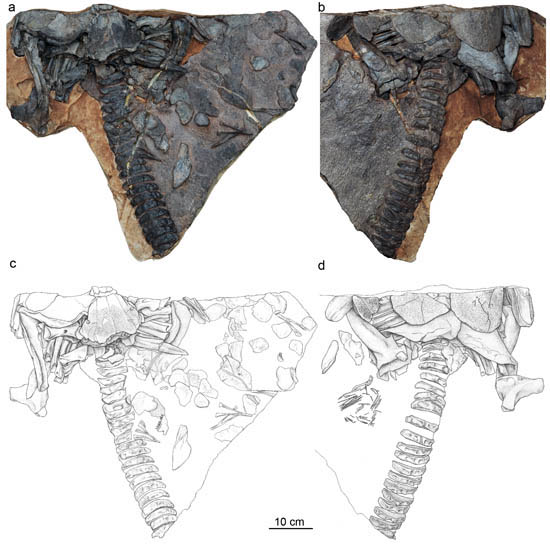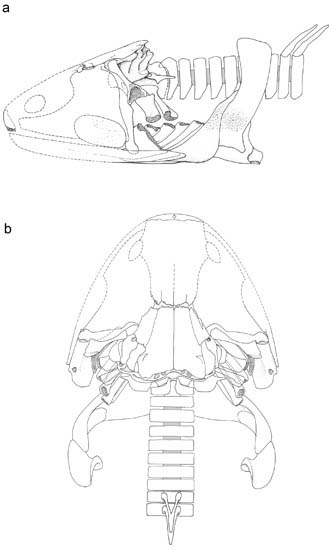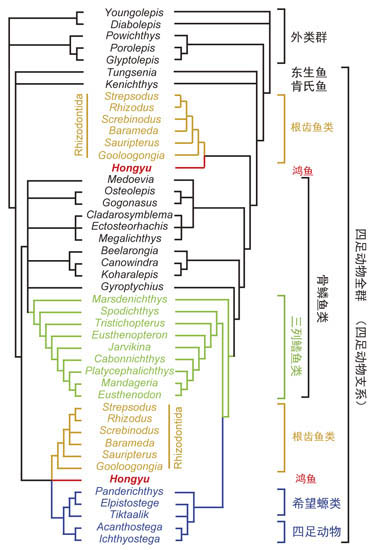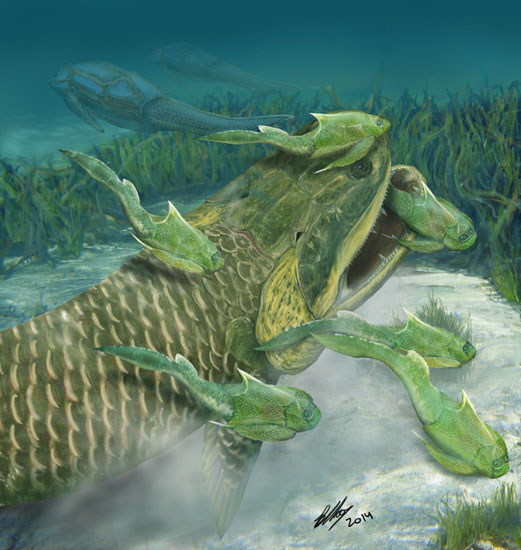"Nature" (Nature) sub-journal "Nature Ecology & Evolution" (Nature Ecology & Evolution) published online on September 4, Zhu Min's team from the Institute of Vertebrate Paleontology and Paleoanthropology, Chinese Academy of Sciences, on the fish landing New progress in the research field. They discovered a 370-million-year-old ancient fish in Qingtongxia, Ningxia - Zhou's Hongyu. The fish has a body length of 1.5 meters and has the characteristics of root-toothed fish, salamanders and tetrapods, revealing that The characteristics of fish adapting to life on land have appeared many times, and the process of fish landing is far more complicated than previously recognized.
The common ancestor of all land vertebrates (tetrapods), including humans, can be traced back to fish that landed in the Devonian period more than 300 million years ago. More than a hundred years of fossil discovery and in-depth research have painted a general picture of the process of fish landing on land. It is now known that tetrapods evolved from a branch of lobe-finned fish. Tetrapods and this lobe-finned fish are collectively called the tetrapod branch or tetrapods. In addition to terrestrial vertebrates, the tetrapod branch also includes some fish-shaped members living in water. They are called the tetrapod stem group. Its oldest representative is the Dongsheng found in the Early Devonian strata of my country. fish and kennedy fish. Tetrapod stem groups were very prosperous in the Devonian and Carboniferous periods, firmly occupying the ecological niche of large shallow-water predators, and evolved into salamanders such as Tiktaalik in the late Devonian period. It is very close to the earliest four-legged animals. The members of the complex group of tetrapods between the genie fishes and the salamanders can be classified into two branches: the rhizodonts and the bony fishes. Among them, three-row finned fishes among bony fishes, such as the famous Eupalomata, are similar to hope salamanders in many aspects, so hope salamanders and tetrapods are considered to be a branch of three-row finned fishes. evolved, while rhizodontids were in a more primitive position in the tetrapod stem group. In the past 20 years, despite the continuous discovery of new fossils, this evolutionary structure has remained roughly stable.
The Devonian ancient fish discovered by Zhu Min and others in Qingtongxia, Ningxia, broke this structure and cast a cloud of doubt on the picture of fish landing. The Shixiagou section at the junction of Qingtongxia and Zhongning in Ningxia exposes the classic Devonian fish-bearing strata in northern China. The earliest tetrapod fossil in China - Pan's Chinese salamander - was discovered. In the summer of 2002, Zhu Min, Zhao Wenjin, Jia Liantao and others accompanied Professor Per Ahlberg of Uppsala University in Sweden to inspect the Shixiagou section, and unexpectedly discovered a row of fossil sections on the steep wall of the quarry. With the help of quarry workers, they removed about one meter square of heavy sandstone from the steep wall and transported it back to Beijing. After nearly a year of careful repairs, they were pleasantly surprised to find that it was a well-preserved large lobe-finned fish fossil, with more than 20 vertebrae alone preserved. Unfortunately, the front end of the head had broken off before discovery and may have become part of the road bed. After restoration, the individual represented by this specimen was up to 1.5 meters long. They named this ancient fish Hongyu chowi, named after academician Zhou Mingzhen, an internationally renowned vertebrate paleontologist and winner of the Simpson Medal.
In the Late Devonian when Anchovy lived, there were many large lobe-finned fish representing different branches of the tetrapod group in the waters of Europe, North America, and Australia, and true tetrapods and their close relatives, the salamanders, had also appeared. After detailed research, Zhu Min and others found that Hongyu has the characteristics of many taxa. The shoulder girdle and the joint structure of the scapula and forelimb bones show striking similarities to the salamanders and primitive tetrapods. An occipital joint has appeared between the first vertebrae of Hongyu and the skull, and the shoulder girdle exoskeleton is disconnected from the skull. This is also different from other fish living in the water, but consistent with land vertebrates. This shows that Hongyu has become very Adapting to life on the shallow water shore is not far from a true landing.
But on the other hand, Hongyu has many characteristics of rhizodont fish, such as the contact between the superior temporal bone and the outer temporal bone, strong shoulder girdle with a high clavicle spine, thin round scales, and high facial lobe of the premaxilla, enough to It is included in this group. Rhizophora is a group of mysterious large predatory fish. The largest Rhizophora can reach 7 meters in length and is known as the "Carboniferous water monster". As early as more than 200 years ago, huge teeth belonging to rhizodont fish were discovered in the Carboniferous coal seams near Edinburgh, Scotland. They were initially thought to be crocodile teeth. Some famous early paleontologists, such as Richard Owen, who proposed the term "dinosaur", Huxley, "Darwin's fighting dog", and Agassiz, the "father of paleoichthyology", all studied roots. toothed fish, and there has been a fierce debate about this. In the last century, because the arrangement and structure of the even-finned bones of rhizodontids were very similar to those of tetrapods, the academic community once believed that rhizodontids were close to the node where fish landed. However, more than 20 years ago, in the Devonian strata of Australia, More and more complete rhizodont fish fossils were discovered, shaking the status of rhizodont fish as "close relatives" of tetrapods. In the subsequently proposed evolutionary structure of the tetrapod stem group, although rhizodontids are still in the tetrapod branch, they have moved down to a more primitive position and are distantly related to the tetrapods.
The mosaic characteristics presented by Hongyu pose new challenges to this architecture. Are rhizodontids or bony fishes the "close relatives" of tetrapods? The fish landing process has become suspicious again. Zhu Min et al. conducted detailed and in-depth character analysis on tetrapod stem groups and established a feature matrix including 33 members of the tetrapod stem group, 5 outgroups, and 169 features. Based on Bayesian analysis and most parsimonious analysis, two different phylogenetic relationship frameworks of tetrapod stem groups were obtained, and the main difference lies in the position of rhizodont fishes. The results obtained from the Bayesian analysis still support the original position of rhizodontids in the tetrapod stem group. In this framework, the mosaic of features present in the anthonychis reflects a large number of convergences between the rhizodonts and the tetrapods, with fish adapting to terrestrial life appearing many times. The results obtained by the most parsimonious analysis resurrected the central position of Rhizophora in the process of fish landing. The characteristics of Hongyu indicate the close genetic relationship between these three groups. Hongyu and Rootfish Toothfishes are the fish closest to salamanders and tetrapods.
Based on the existing fossil data, it is difficult to choose between these two theories. But in either case, the discovery of Hongyu proves that the morphological differentiation and biogeographical partitioning levels of the tetrapod lineage have been greatly underestimated in the past, and that the Devonian rhizodontids and bony scale fishes were moving toward adaptation. There has been a remarkable parallel evolution in life. These large shallow-water predatory fish belonging to different groups have each tried to expand to land, but in the end only one succeeded.
This achievement was funded by the National Natural Science Foundation of China’s key projects and the Chinese Academy of Sciences’ Frontier Science Key Research Projects.

Figure 1 Photos and sketches of the holotype specimen of Hongyu (photo provided by Zhu Min)

Figure 2 Reconstruction of Hongyu skeleton (photo provided by Zhu Min)

Figure 3 Hongyu classification location (photo provided by Zhu Min)

Figure 4 Ecological restoration map of Anthropus spp., accompanied by Ningxia ichthyosaur and Pleuraeus spp. in Devonian ancient lakes (illustrated by Brian Choo)
animal tags: fish Devonian fossil evolution
We created this article in conjunction with AI technology, then made sure it was fact-checked and edited by a Animals Top editor.